![]()
![]()
![]()
Use LEFT and RIGHT arrow keys to navigate between flashcards;
Use UP and DOWN arrow keys to flip the card;
H to show hint;
A reads text to speech;
122 Cards in this Set
- Front
- Back
|
What us the very first monument shown in the opening? how does this set the tone for the movie?
|
bernini's fountain- "hugging piece", welcoming you in with open arms, st. peters
|
|
|
how is princess ann portrayed at the beginning?
|
a special welcome to london, many people love her, she attends many countries to create allies, discuss trades, meets other powerful people, a ball/dance thrown in her honor on her "european good will tour"
|
|
|
why is she given a sleeping drug? what is her room like? (any art style you recognize?)
|
the drug is to make her feel happy, calm her down from all her royal duties/speeches, etc. the style in her room is baroque, room is very big, floral, headboard has faces, ceiling makes you look up- baby angels at foot of the bed
|
|
|
what aspects of roman culture does she first see when she goes out? where does she fall asleep in rome?
|
she see's cafes, vespas, fountains- berninis, horse carries, she falls asleep on a public st bench where joe soon finds her
|
|
|
what is joe's apartment like and how does it contrast with ann's?
|
he lives with multiple people, small room 1 bed, no artwork anywhere, not ornate, no silk sheets- but ann finally gets to sleep in real PJ's
|
|
|
how is the roman market typical of an italian outdoor market?
|
lots of people always walking, vespas, music, crates of different foods/fruits to buy/try. people wheeling & dealing others to buy. she buys shows then get her hair all cut off, then gelato, and one flower from a floral man, she admires the window shopping
|
|
|
how do joe and ann spend the day and evening together? what aspects of roman life do they experience?
|
both shopping in market, haircut, go to a sidewalk cafe-joes friend meets them, smoked her 1st cigarette, rides on a vespa, goes to colosseum, friend is trig to takes pics of their adventure around town, she out drives police on vespa- go to police station- talk their way out of it saying their newlyweds- people cheer- go to wall of inscriptions (to tell the truth), end at dance club runs into hairdresser, fight breaks out
|
|
|
what roman monuments did you recognize? in which scenes?
|
fountain while getting her haircut, steps/stairs, colosseum, mouth of truth, wall of inspirations and wishes
|
|
|
what italian words did you hear in the film that you recognized?
|
"capito"- when maid yelling at ann, "grace"- thank you, coffee, "señorita", "chow"-bye, "canto", "baachi"-kisses
|
|
|
overall, how is the city of rome depicted in this film, and what impressions did it leave you with?
|
the everyday life of a Roman, day to day activities, lots of sight seeing, sidewalk restaurants, cart food vendors, fountains, dancing, liveliness, friendliness, "basra"= enough, they love marriage/weddings, etc.
|
|
|
baachi
|
means kisses, Italian often signing off their letters
|
|
|
rome
|
• “all roads lead to rome”-
• different from all Italy- people, everything about them is different • in its own city= own culture, certain dialect, roman dialect • proud culture • more modern • pantheon-inspiration for B. dome and dome that stand over St.Peter’s |
|
|
Michelangleo fresco over Sistine chapel
|
• 1508-1512- ceiling he painted
• the building constructed under a pope sicstus→ Sistine • had chapel built for private prayer chapel • pope Julius- reining pope in 1500s, big ego, named himself after Julius cesar, be same political leader that Julius was, patron of the arts, aware of artistic boom in Florence wanted same thing for Rome |
|
|
Michelangleo fresco over Sistine chapel
|
o commission michelangleo to paint the Sistine ceiling
o “greatest one man piece of art of all time” – had no assistants, fired all assistants after 3 days, preferred to do it on his own, painted it for 4 years, myth he painted it on his back but he painted it standing, wrote poetry about how it ruined his eyes, back, life- so uncomfortable o he never wanted to paint the ceiling, considered himself a sculptor, didn’t think painting was of high as an art form as sculpting, sculptor= being strong, strong hands, labor, etc. o he wrote- I decline the offer, but thank you not interested, signed it “Michelangleo, sculptor” o painting is stories from genesis- creation of adam, & eve, temptation & expulsion, noah and the flood, the separation of light & darkness, creation of the sun, moon, and planets |
|
|
• the story of god giving life to adam
|
o first image of god
|
|
|
• eve
|
o criticism of michelangleo couldn’t paint women, just painted men with breast
|
|
|
Ceiling
|
• use of shadow
o restoration and cleaned it- wasn’t shadowed was very bright just dirty o used contrasting and bright colors o entire ceiling is decorated o 1st panel he did- flood of genesis-→ god sent down a flood to re-purify everything/one o showing struggle, despair, finding higher ground, o use sponge, soap and water to clean it o only light by candles no real light, covered in all kinds of stuff o Japanese company paid for entire restoration, they get all photo rights for eternity o Innudie- “the nudes” o Creation of the sun and the moon |
|
|
The story of the drunkness of noah
|
• In genesis
• About respecting your father, elders |
|
|
Expulsion
|
• Copying Masaccio garden of eden
• Uses masccio exact composition, borrows heavily 1st half revealed in 1510 • People loved it right away • Immediately universal success, no way to reproduce in pictures • Word just got around • This and David considered his 2 master pieces |
|
|
The last judgement
|
• 25 years later asked to paint
• painted the alter • story; one day jesus will come back and decide who goes to haven and hell • 100s of nude figures some going to heaven some dragged to hell • Dante inspired michelangelos version of hell • Angels/trumpters welcoming people to paradise • St barthobul- holding own skin in his hand, put self portrait of michelangelos face in the skin • Everything in hell- can be read in dante inferno • Restored, fresco added later • Pope Julius commissioned this |
|
|
Pope Julius
|
• Greatest patron of the arts
|
|
|
the colosseum
|
• construction was started in the year 70AD under emperor Vespasian
• built on concrete and stone • stone was just made- didnt know what was going to happen when building with stone- hoping for best • wasn’t finished until 10 years later under son titus- 80 AD • worlds largest amphitheatre 50-60,000 • originally called flavian amp. After the emperor • got the name “coloseeum” after the colossus statie of nero next to it |
|
|
the colosseum
|
• designed showcased all romes wealth, knowledge, power of city
• outside decorated with limestone, marble, upper arches were adorned with ornate states of roman gods and divinities, made out of marble and limestone, often with gold. 2500 statues • the finished product 615ft long by 510 ft wide, 187 ft high, base area of 6 acres • roof had a retractable awning called the velarium • admission free, but had to get membership card, sat with status, senate seats made of marble |
|
|
the colosseum
|
• fighting sand arena is 287 ft long 180 ft wide
• built on stone foundation network of tunnels and trap doors o included animals pins, and levels for gladiators to rise on o gate of life & death on each side, if won- gate of life, died- dragged to gate of death left corpse • the trap doors led to cages with wild animals • elephants, tigers, lions, etc. held captive • atleast 500 animals were killed in a lifetime of the colosseum |
|
|
the colosseum
|
was built as an amphitheatre arena for people of rome to watch;
• gladiatorial contest- wild best hunting, naval battles, and a variety of shows • show began at day break, finished at sunset • days of games, more important ones lasted longer • when finished celebrated with 100 days of straight games • gladiatorial fight to death b/n slave fighters, were trying to please crowd • had to swear” I will endure to be burned, to be bound, to be beaten, and to be killed by the sword” • victor would wait for sign (thumbs up/down) from life or death • naval battles and chariot races o flood and then brought ships in to reinact |
|
|
destruction
|
• within its 5000 yrs colosseum was hit by many earth quakes external/ internal damage
• hit by fire • during middle ages plundered /robbed • took bronze to make shields/swords • many stones were taken to make other parts of rome • since the last battle, has been used as church, cemetery, etc. huge tourist attraction |
|
|
pieta- by Michelangelo
|
• 1489-1499
• in st oeters basicila, vancian city • commissioned for French cardinal • made out of carrara marble, was made for the cardinals funeral monument but then moved to st. petes • moved in 18th century • title of pieta is not actual titel bur rather a name give to this particular scene of mary holding jesus body→ greek & Italian word means “pity” • only masterpiece michelangleo has signed • theme of sculpture was famous in france but not Italy at tie • shows classical beauty in naturalism • was an art piece during renaissance • life sixe • figures seem to be out of proportion |
|
|
• 1489-1499
• in st oeters basicila, vancian city • commissioned for French cardinal • made out of carrara marble, was made for the cardinals funeral monument but then moved to st. petes • moved in 18th century • title of pieta is not actual titel bur rather a name give to this particular scene of mary holding jesus body→ greek & Italian word means “pity” • only masterpiece michelangleo has signed • theme of sculpture was famous in france but not Italy at tie • shows classical beauty in naturalism • was an art piece during renaissance • life sixe • figures seem to be out of proportion |
• this sculpture made Michelangelo famous
• sculpted mary to be younger on purpose, wanted to not represent death but religious vision of abandonment • mary to look youthful “incorruptible purity” • process of sculpture took less than 2 years • over heard cristoforo solaris work so immediately put his name on it o Michelangelo from Florence did this • Created it that marys left hand suggests we must grief with her loss of son • Version of pieta is remarkable because he stayed true to humanist ideals of the renaissance and physical perfection of beauty • He later regretted carving his name, too much pride, promised to not sign again • Damaged with being moved, marys 4 fingers • On may 21 1972 was when most damaged occurred • Mentally ill geologist Laszlo walked up to and tried to sledge it with a hammer→ said im jesus Christ • Bullet Glass surrounding it now • 25 replicas all over the world • nose was broken, restored chunk from her back |
|
|
baroque Rome
|
• began in 1600s
• renaissance begins in 1400s in Florence • baroque started in Rome in 1600s • spreads throughout Italy- than all of Europe • paying for indulgences- exposed by church in 1500s, protestant counterreformation • trent- talked about restoring their power back o put money into arts, city—get people back again- used for political power |
|
|
• Baldacchino Bernini
|
rome is often referred to as bernini’s rome
o His art is everywhere o Impossible to walk through rome and not see his work o Had him design the main piazza infront of st peters church o Designed as arms- reaching out and giving you a hug- design piazza so that when you walked to the church you had the sense these giant arms were giving you a big hug o Welcoming you back or into the church |
|
|
Baroque art
|
Meant to attack your senses- feel a reaction (+) with regard to the catholic church
• Ren. Art more intellectual you think about it • Art of baroque “hunts you down”-shapes, spirals, makes you look up into the “heavens” • More decorative and ornate work • Eye looks up • Counterreformation- welcoming of god- looking up to paradise • Lot of bronze • Spiraling columns, again take eye upwards, lots of detail, ornate/decorative! • Putti –little angle, arab, chubby little baby—no purpose • Twisting vine also going up • Sculptors using different materials to “attack our senses”- color contrast |
|
|
Pope at time Urban the eighth
|
• See lots of bees around Rome- symbol of the family
• Pope Julius family symbol- acorn |
|
|
Bernini
|
• Most famous sculptor of baroque era
• Story of Apollo & daphine, roman god and nymph daphine, Apollo hit by cupids arrow, fell in love with he- she didn’t want him, running through the woods praying gods for him to stop as Apollo catches up to her she turns into a tree o Her hands sprouting branches & leaves, leaves are spreading roots • Baroque o Into drama o Attacking senses, etc., high drama, lots of energy o Baroque artist always Chooses moment of highest drama |
|
|
Berninis David
|
• In action—the action shot
• Older version of david • Not so much nude like others • Period of counterreformation—catholic church said not appropriate to have so many nude bodies • Making an actual facial expression—determined, intense • Interest in human body and perfecting- HIGH DRAMA |
|
|
Borgasse
|
• Bought art first and built a vill around it – now “borgasse gallery”
|
|
|
ROME
|
• Many Bernini plazas that have foundations are his
"BERNINIS ROME" |
|
|
Ecstasy of st. Teresa
|
• St. Teresa was Spanish nun living in 1500s, writer, wrote about religious experience, wrote famous saying “she was sleeping & an angel pierced with a hot golden arrow and was put into a state of esctacy—head is thrown back
• Golden rays as if carried upwards to paradise, resting on a cloud • In a small church in rome, santa maria… • Bernini built this into the chapel, natural light comes into the “rays” |
|
|
the power of art-berini (complete episode)
|
• wife was cheating on him with his brother
• beat up brother, ordered to have wife’s face slashed- “immortalize her beauty”- never love anybody else • shape marble almost as if it were clay • Urban the 8th commissioned majority of his work, wanted another Michelangelo-another great artist • Baroque art more emotional • Apollo and daphne story • The French said it “couldn’t be kept in a house” because it could “arouse people” • Lot of similarities to Michelangelo |
|
|
the power of art-berini (complete episode)
|
• In 20s protige
• Handsome, regal, being noticed • Nickname “ el calverra” → “the knight” • Known for giving life to the sculptures, life & energy • Eyes very realistic, “rape sculpture” digging of hands into her skin • Tried capturing the moment, ex. burning his own arm to see facial expression • Long career- every pope feels close to him • Cadvargo- great painter, different in character, drunk, fights, hung out with street people, trouble, killed someone |
|
|
Roman holiday monuments
|
• mouth of truth-legend put hand in and lieing
• castle st. angelo- dancing scene • colessesum- driving vespa • falls asleep in front of roman forum • treve fountain, surrounded my horses- thrown coin into fountain will come back to Rome • Spanish steps- giant outdoor staircase by Spanish embassy- getting haricut • Having lunch right by the pantheon • Wishing wall • “Conto”- check,- in Italy must ask for the check, different philosophy of eating, wont rush you-rude • “basta”- enough • “bambino”-children • “scuzzi”- excuse me • “bona fortuna”- good luck |
|
|
art of rome
• Caravaggio |
o Contemporary of Bernini- 2 different personalities
o Berini- catholic o Carvaggio- getting drunk, st people in paintings, stories about him , killed someone over a bet in a tennis game o Changed the course of art history |
|
|
The conversion of st paul
|
• Conversion to Christianity
• Riding in the middle east, name-saul, blinded by divine light “divine light of god” to where he fell of the horse • Painting was very controversial • Everything berini did was liked in contrast to Caravaggio • Main character in painting is the horse- looks like stepping on him • Known for unusual compositions carv. • Known for painting the “ugly in art” man behind horse- ugly, old, dirty |
|
|
Chiaroscuro
|
• Very intense contrast between light and dark
• Known in baroque era • Increase drama |
|
|
Caravassista
|
• Person who worked in carvaggio
|
|
|
The Madonna of the pilgrims
|
• People on religious quest to meet baby jesus
• Local Madonna was a prostitute (model)- people would recognize her from the painting • Use street people as models for his paintings- lots of paintings rejected by churches • Pilgrims have back to us |
|
|
Known for being;
|
• Extremely skilled painter- 1st work with fruit baskets
• Carv. Puts his self portrait in the head of goliath- at this point banished from rome for murder- trying to come back to rome • Pope gave him a pardon for the painting- never made it back to rome, mysterious death late 30s |
|
|
Crucified st peter
|
• Christ best friend, founder of church
• Crucified upside down didn’t want the same way as jesus • Black background • Positioning of people- no one ever just standing |
|
|
Version of Judith and Holland
|
• Neighboring towns at words
• Judith seduces Holland and cuts his head off= hero • Baroque- high drama, attack on the senses • Blood spurting out of neck • Maid servant is ugly/witch • Rich colors- golds/reds |
|
|
Milan
|
• Most famous work in Milan→ the last supper
• Very modern city • Fashion capital of the world • North- more productive economically • Torino- where car industries are • South-agriculture, economy not flourishing as much • In church santa maria • In refactory where the munks ate dinner • Consider last supper to be leonardos master piece • In 1960s many southerners moved to north for economic boom- big discrimination • Southern Italy starts from rome down—“the real itay” o Gardens, food, slower life style • Milan, torino o Bussiling, fast, fast food • Most famous monument is there cathedral- very gothic • Cathedral sets the tone for the city- took 600 years to finish it, variety of styles |
|
|
milan
|
• Leonardo- a “renaissance” man, he could do it all- all different types of sciences, art, etc.
• Obessed over human body, and how brains work, left handed- words backwards • Botanist- knew all about flowers • Painting about one disciple that will betray him – Judas • Window in the back- resembles halo over Christ head • Lots of depth & linear perspective • Emotion- many people drawn to the disciples all reacting in a different way to his announcement that someone will betray him • With last supper- decided to experiment with new fresco technique • Perfect setting for all to eat together • Climate controlled, 6 doors to get to painting, so cold need humidity, only get to stay so many minutes • Instead of mixing colors into wet plaster, he used a paint on the plaster that you would’ve used for a portrait • Started detiorating immediately • No eating in that room only look at painting but could in the 1500s • Walking in feeling the “presence of Christ and his disciples” feeding |
|
|
milan
|
• Almost as sacred as its subject
• Speaks outside of Christianity, go beyond Christian belief • Most Christian artwork in the world- almost died in the war • Only 15 minutes • one of the most famous paintings in the world • 30 ft long by 15 wide- covers entire wall • figures are life size • judas clutches the money bag • every artist needs a patron • Sforza family that was ruling family in Milan that commissioned Leonardo for his work • Patrons buying there way to get into heaven • He though by commission the last supper he would be in purgatory less time, or into religious scenes sometimes had themselves into them • Art used politically • Significant about last supper- foreshadowing, all different emotions from 12 disciples, unvailing of it was like unvailing a brand new computer, • Parents no married, weird for renaissance, usually son must go into fathers career “accountant” • Both left & right handed, sent him to learn the arts |
|
|
Mona lisa
|
• In the loove in paris
• Napoleon stole it, Italians still mad about it and haven’t given it back • Controversary of her slight smiling • Leonardos technique was “sfumato” smoking, dark background • Eyes following you around • Being pale was luxury in this time- meant rich wasn’t a farmer • Extra weight good things- you weren’t hungry, plenty to eat, life plentiful • Being doughy & pasty in renaissance good thing • Mona lisa- not pale or doughy • Portrayed as beautiful • Background is more logical part of the painting • Last supper masterpiece of milan |
|
|
bernini’s fountains
|
• Gian Lorenzo Bernini
naples. 4 dec 1598- rome, 28 november 1680 o famous artist and architecht working in rome o baroque sculptor • attacks the senses, dramatic, action-packed, orante, elastic apoolo and daphne the ecstacy of st Theresa rape of peresphone o emphasis on action, drama, light, viewing angle o personality; big ego, violent, rude, but considered II Cavaliere and was close to the pope o also designer of st .peter |
|
|
Fontana dei quattro fiumi
|
• Located in the center of piazza novena
• Bernini won a competition and was commissioned by pope innocent x in 1646 o Controversial o 1648-1651 • depicts gods of the 4 great rovers in 4 different continents surrounding an ancient Egyptian obelisk • each enhances with animals and plants native to that continent • symbolizes the rise of the catholic church |
|
|
the nile→ the mysterious river
|
• Africa
• Sculpted by giacomo anotnio fancelli • The gods head is draped in a cloth o Unknown river source • Looking unresponsively across the piazza o Ignorance of the obelisk’s symbolic light • Palm tree |
|
|
The ganges
|
• Asia
• Sculptd by Claudio poussin • Long oar o Navigation • Sea serpent • Lion |
|
|
The Danube
|
• Europe
• Sculpted by Antonio raggi • Points towards the popes coat of arms o Three fleurs-de-is and a dove with an olive branch o Close to rome • Horse |
|
|
The rio de la plata→ amazon
|
• South America
• Sculpted by Francesco barrata • Sitting on a pile of coins o Wealth of the new world- money America giving to Europe • Shields his eyes from the blinding light o Recent colonization of Christianity in the Americas • Armadillo |
|
|
Facts
|
• A place where carvaggio would hangout- at fountain
• Commissioned by catholic church • Angels & demons movie has brought more tourist • Often come up with conception, model, and ideas for fountain and have other sculptors finish them • Bernini got them started and hired best sculptors • Only took 4 years to build |
|
|
Caravaggio
|
• Postman artist
• Art considered more naturalism- into details od realistic figures • Trained as painter in Milan • Naturalism vs realism relates to the ides of tenderism- attack senses • Idea where he was famous in time he lived, after death immediately forgotten took till 20th century to be appreciated • “creates modern painting” • style of art is recognizable for its realism, chiaroscuro, and co-extensive space. He is also known for the refusal of fresco paintings and preliminary drawings • lots of self portraits |
|
|
boy with a basket of fruit-1593
|
• realism
• depicted so professionals could understand it |
|
|
musicians- 1595
|
• purity of skin
• 1st self portrait of Caravaggio himself |
|
|
Amore- “love conquers all” 1601-1602
|
• cupid around ideas of music, science, and war
• love powers of these depictions • realism- crooked teeth & grin, relatable in a modern day sense |
|
|
Judith 1598-99
|
• Chopping his head off
• Attended an execution before- used later for painting |
|
|
St. Thomas 1601
|
• Wrinkle, forehead
• Finger going to Christ womb • Drama, theatrical lighting from top of painting |
|
|
Intumine of Christ
|
• Christ as fully pale white figure
• White- talks to his full purity opposed to clothed dark people • Counter reformation • Focused on all figures just not Christ • Virgin mary- older lady instead of eternal youth |
|
|
Supper 1601
|
• Figure all the way right reaching out to figure to join supper
|
|
|
Taking of Christ
|
• Novel about it
• Trying to figure out if real Caravaggio because “caravaggiest” mimicking his paintings |
|
|
Facts
|
• St Mathew cycle
• Was previously decorated by cavailir daprino • His decoration to the contarelli chapel- st Mathew cycle here • 3 paintings regarding st. Mathews life the calling of st Mathew-1599-1600 • tax collector, jesus coming to him as a disciple st Mathew and the angel-1602 • destroyed in 1942 for ww2 • angel getting into st Mathews personal space matrydom of st. marhew 1599-1600 • st Mathew being killed by Ethiopian king • disapproval for lust • after 1600 a lot of commisions going to Caravaggio and controversies |
|
|
grapa
|
• grapa- famous after dinner drink- supposed to have after a big meal- made of skin of grapes- 45% alcohol
• southerners were too poor for grapa so made their own→ called “bathrub grapa” lemons, sugar, grain alcohol- lemon chello |
|
|
Venice- “venezia”
|
• City built entirely on water
• Connected by bridges- over 100 islands • No cars allowed or vespas- quiet cities • Travel by foot or gandalla- been around since 1700s • Boat taxis • “the most serene”→ la serenisma- went for 1000 yr as an independent republic, only European city to have independence that long • powerful city • the grand canal- major body of water • houses built on stilts down in the water • city over 2000 years old built on wooden stilts • on adriatic sea • impossible to take it over on foot • Venice and Milan great enemies • For many years, Venice would have a ceremonial “marriage” to the sea, Venice was married to the sea- therefore the sea obligated to protect her |
|
|
Trade
|
• Perfect location
• Rich and prosperous city in middle ages, ren. , baroque, etc. • Had a bunch of trade routes to the east • Marco polo- greatest Venician explorer went back from Venice to the east • Spices, silk, pasta-china, drugs, perfumes came in • Venice exported timber, wine, raw materials, wool • St. marks cathedral- main basilica • Flooded • Venice known for significant flooding- slowly sinking • One of the most enchanted citied in the world • Michel angelo stated “looks like a big painting” • No other world in the city is like this • Carnival- celebrated same day as mardi gras- people come from all over the world to party and look and art/design, costumes taken very seriously, all custom made- think ahead to plan outfits |
|
|
facts
|
• Doggi palace- ruling family lived
• St. marks always covered with pigeons • Edge of great canal- gandallas parked • Dante mentions Venice- about great arsenal • Pope didn’t like that people were questioning if there was a god at the coffee shop- banned it, coffee was a devils drink • Drink coffee in the oldest coffee shop • St.marks- built 1060- medieval style |
|
|
Hia sohpia
|
• In modern day turkey, Istanbul
• During venice thriving time was in Constantinople- now modern day turkey • Constan.- when roman empire 454 ad, romans moved capital here • Named after himself- re-establish its power • Lot of contact between mainland Italy and the new power • Eastern style • Venice more eastern style than rome or Florence • All based off symmetry • Inside covered with mosaics • Can worship there too • St marks covered with mosaics too • Islamic influence- hia Sophia- constant trade b/n east & west • “byzantine” influence • lots of gold, decoration • all mosaics 2D • recount stories from old/new testament- latin & greek |
|
|
facts
|
• primary form of art in middle ages- mosaics
• clay, glass, shell , whatever artists can find • “craftsmen”- no artists, anonymous, worked all together • jewels came from the east too • many famous Italians came from venice-1300s • first public opera house in venice • multicultural city- cities before all catholic • 1st jewish ghetto in venice • other places to worship different religions • adopted the “don’t ask don’t tell” policy • diverse city • to a certain point “what happens in venice stays” • more contact with other cultures- diverse ways of thinking • 1st printing press pattoned in venice- developed for literature • taken over by Austrians 1700s • then joined Italy republic |
|
|
vacanza
|
vacation
|
|
|
doge palace and the bridge of sighs
purpose |
• place for the republic to operate
• residence of the doge • prisons and interrogation rooms in basement • 1996, been museum |
|
|
doge palace design history
|
• first built in end of 10th century, law courts, admin office, ballrooms, prisons
• much of the gothic style arch. Added in 1340 • in 1574, 1577 fires destroyed a lot of the building • additional prison cells were built across the canal in 16th century were accessed by bridge of sighs |
|
|
design
|
• 3 wings- inside part- courtyard
• canal side • wing facing water was built in 1340-hall of great council • wing toward piazza was built in 1424 contains salla dell scrutino- court room |
|
|
materials
|
• marble
• decorated with sculptures by filippo calendario • inside; stucco with painting, very ornamenta |
|
|
doge of venice
|
doge is the chief magistare and leader of the republic
• like the emperor, we was regarded as the civil military leader • forst doge elected in 697 • last doge abdicated in 1797, napoleon conquered |
|
|
bridge of versailles
|
• bridge in venice
• passes over rio de palazzo • connects the new prisons to the old prisons • designed by antoni contino, built in 1602- nephew of bridge builder • known as one of the finest examples bridge arch. In world • white limestone • 2 windows with stone bars • 11m wide • sculptures depicting mostly sad/angry faces • hard to see outside the bridge from the inside |
|
|
name & legend
|
• prisoners would sigh at their final view of freedom (before being executed) while crossing the bridge
• sighs come from lovers, if couples kiss under the bridge while drifting below at sunset, they will enjoy eternal love • inspired by poet lord Byron |
|
|
Antonio lucio Vivaldi
Early life |
• Born march 4 168- 28 july 1741 in venezia
• Born into poor family, at 1 forced to study to be a priest • His father was giovannai battists who was a pro violinist, learned how to play- made him play cause could play wind instruments • Chest problems • “the red hair priest” |
|
|
adult years
|
• was ordained at age 25, withdrew from priesthood for health
• 1704 joined one of 4 orphanges, ospedale della pieta- for female children abandoned or families unable to support them • ospedali was for girls who were bastards • deemed maestro di violono • la peita had the best music training for music |
|
|
mid life
|
• after 1709, he wanted to branch out and receive recognition as a composer
• baroque created musical genres • vivaldo received patronage not only from la pieta, but from foreign rules, like Louis XV who commissioned the serenade La ena festeggiante (festival on the seine), dated after 1720 • Vivaldi found himself a patron as cardinal pietro ottoboni, Fredrick of Denmark, and the grand prince of Tuscany • In 1713 created first opera, ottone in villa, and started a tour, played a private audience in favor of pope • 1723, asked to create 2 concentros every month as well direct rehearsals for the pieta • big ego |
|
|
four seasons
|
• l’autunno
• most famous • movements • spring-E major, summer G-minor, autumn F-major, winter F-minor • Vivaldi created a sonnet for each season |
|
|
Allegro-autumn
|
• Peasant celebrates with song/dance the harvest safely gathered in
|
|
|
Allegro non molto-winter
|
• Shivering frozen mid the frosty snow in biting, stinging winds
|
|
|
Allegro-spring time is upon us
|
• Birds celebrate her return with festive song
|
|
|
Presto-summer
|
• His fears were justified, the heavens thunders and roar and majestically cuts the head off the what and damages the grain
|
|
|
duomo di Milano
|
• construction began in 1386 under bishop Antonio da saluzzo
• completed in 1965 • under regime of many architects • dedicated to santa maria nascente • one of the largest churches in the world • 3159 statues in total • capacity 40,000 • marble statues • mainly gothic |
|
|
location
|
• defines the city center
• former roman city of mediolanum • constructed atop the ruins of the former roman baptistery and basilica of sanata maggiore |
|
|
early years
|
• under gian galeazzo Visconti
• candolgia marble sued • brought in many French and German architects for new ideas- sped up process • Visconti died in |
|
|
Sforza era
|
• 1452-3/4 nave (interior) people sit, aisles completed
• small interior dome completed with 15 statutes of saint and prophets • guhliteeo dell amadello installed stained glass carlo borromeo era • archbishop carlo brought catholic reformation and renaissance to duomo • Pellegrino pellegrini appointed as chief architect • Quadroni added paitings of san carlo • 1614 choir stalls at altar added • front façade still not completed |
|
|
Federico borromeo
|
• New chief engineer carlo buzzi decided to return to gothic style
• Roof covering completed, now can go on roof • 1762 crossing completed on façade with copper madonnina on top • nothing built taller than this • when can see Madonna= clear day |
|
|
20th century
|
• five bronze door was erected in mid 20 cent. Depicting mary and st. ambrose
• completed with final gate on jan.6, 1965 • major restoration work to combat weather and pollution |
|
|
modern day uses
|
• the church of the archbishop of Milan (carinal angelo scola)
• church as regular holy masses • huge tourist attraction (on roof) • nail celebration- bring nail down from jesus statue every sept.2 to celebrate |
|
|
Leonardo reading
|
• From Tuscany
• Known for paintings, most done in Milan • Comissioned, big patron Sforza family • Ruling family in Milan during renaissance • Major works in Milan-last supper • Mona lisa-florence |
|
|
Why was he in Milan?
|
• He thought his science and inventions would be more appreciated in Milan then Florence
• Formally trained in art not classics- didn’t know how to speak, read latin • Different type of edu. Then other artists • Scientist, artist, inventor, musician, mathmetician • Wanted to go for inventions, help with inventions for war, knew how to make bridges, cannons, engineer • When first got there he opened up his own art school an taught people, before comissioned |
|
|
• Madonna of the rocks
|
o Loves using linear perspective
o In setting of the cave o Angel, Madonna & chid, st.peter o Cave to paint rocks? |
|
|
• Madonna, child, and other
|
o Put alps in there
o Constant observer of landscape and nature |
|
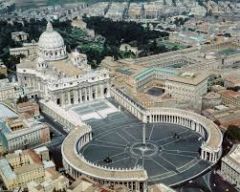
|
st. peters- bernini-1626
|
|
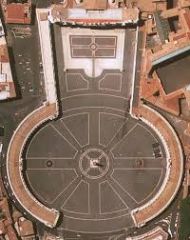
|
berinini peters piazza-1626
|
|
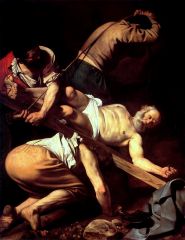
|
caravaggio- crucifixation of St. Peter-1600–1601
|
|

|
carvaggio-1598–1599-Judith and Holofernes
|
|
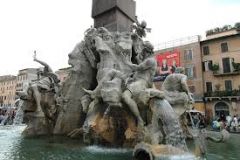
|
bernini-1651-Four Rivers Fountain
|
|

|
bernini-david-1623–1624
|
|
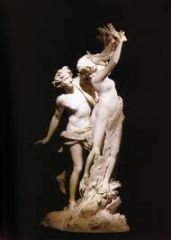
|
bernini-Apollo and Daphne-1622–1625
|
|
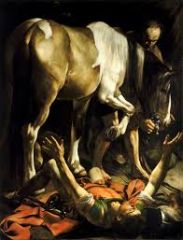
|
caravaggio-1600/1601-conversion of st.paul
|
|
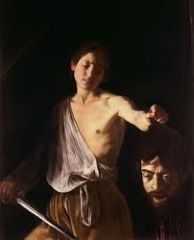
|
carvaggio- david & goliath- 1599
|
|

|
ARTEMISIA -Judith and Holofernes-1611–1612
|
|
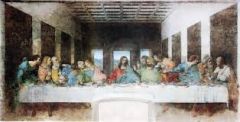
|
the last supper- leonardo da vinci-1494–1498
|
|
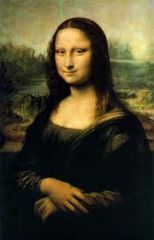
|
mona lisa- leonardo da vinci-1503–1517
|
|
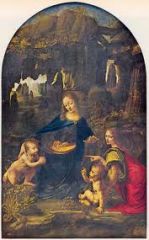
|
leonardo- maodonna on the rocks-1483-1486
|
|
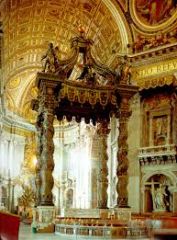
|
bernini-The Baldacchino (Canopy)-1623–34
|
|
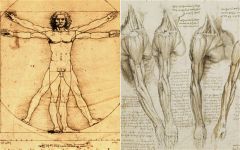
|
leonardo-drawings
|
|
|
NA
|
calling of st mathew- caravggio
|
|
|
what was painted on the ceiling before michelangelo painted the sistine chapel?
|
a starry sky
|
|
|
who were given the worst seats in the colosseum?
|
poor, middle class, and women
|
|
|
which is one of the rivers represented in bernini's "four rivers fountain"?
|
the amazon "rio de la plata"- different river in south america
|
|
|
what affect are bernins columns outside st. peters supposed to have on you?
|
attack your sense, hug and embrace you
|

